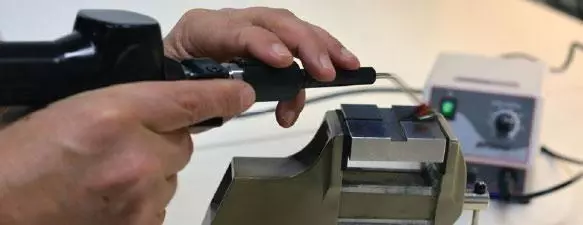Addressing the Challenge of Hand-Arm Vibration Syndrome (HAVS) with the Diprofil Di-Pro Power Hand Tool System
The increasing prevalence of Hand-Arm Vibration Syndrome (HAVS) in the vibrating tools-using industry has raised concern among occupational health and safety experts. To address this issue, the International Organisation for Standardisation (ISO) revised its standard for measuring hand-arm vibrations in handheld tools with reciprocating action in 2014.
Kemet International Ltd offers a solution to reduce the risk of HAVS without sacrificing performance. The Diprofil Di-Pro, exclusively available from Kemet, has been optimised to achieve low vibration levels for tools within a certain weight range, setting a new standard for high-end polishing and filing machines with a focus on operator well-being.
The Diprofil Di-Pro is available with a flexible shaft connection (slip-joint/ball-joint) or an integrated micro or air motor, and a range of tools are available to optimise efficiency and minimise vibration.
In addition to the Diprofil Di-Pro, Kemet also offers a range of protective finger sleeves to provide further protection for operators. Vibration-related injuries are often sustained in the hand guiding the tool, not just in the hand holding the machine. The finger sleeves allow operators to guide the tool without placing their fingers on any moving parts, and come boxed with an extension rod and instructions for attachment.
Vibrations and the Issue Of HAVS (Hand Arm Vibration Syndrome)
Hand Arm Vibration Syndrome (HAVS) is a debilitating condition caused by exposure to vibrating tools and machinery. The EU directive 2002/44/EC, which was approved in 2002 and introduced into national laws by 2005, aimed to minimise the exposure to vibrations in the workplace. The responsibility of minimising vibration exposure is shared between the manufacturer, vendor, employer, and operator.
HAVS is a serious issue, as it can lead to permanent damage to the nerves, blood vessels, and joints in the hands and arms. The symptoms of HAVS can include numbness, tingling, and weakness in the hands, as well as pain and stiffness in the fingers, wrists, and arms. In severe cases, HAVS can also lead to permanent disability, making it difficult or impossible to perform everyday tasks.
To minimise the risk of HAVS, the EU directive requires that all machinery emitting vibrations exceeding 2.5 m/s2 must be equipped with an action plan to minimise exposure for the operators. This plan should include regular health inspections, as well as steps to reduce the amount of time that the operator is exposed to the vibrations.
In addition to the action plan, employers must also take steps to ensure that their employees are properly trained on the use of vibrating machinery. This includes educating employees on the dangers of HAVS, as well as teaching them how to properly operate and maintain the equipment.
Furthermore, the directive requires that the manufacturer, vendor, and operator must ensure that the machinery is designed and manufactured in such a way as to minimise the emission of vibrations. This may involve the use of anti-vibration materials, such as rubber or foam, as well as the incorporation of special vibration-damping systems.

